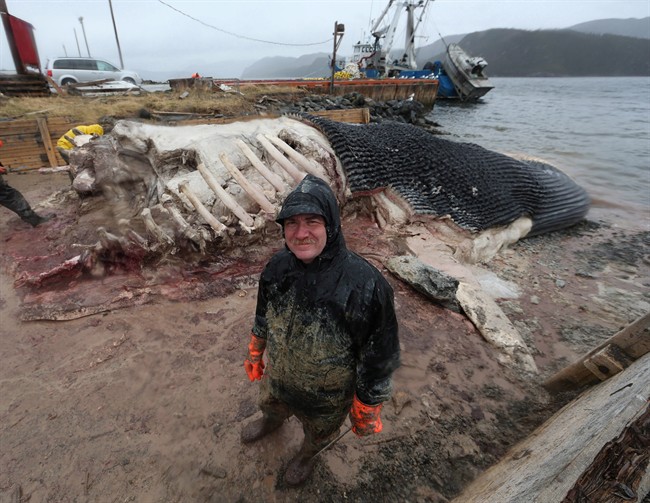TORONTO – When two blue whales washed up on the shores of Trout River and Rocky Harbour, Newfoundland, residents didn’t know what to do about it.

But Mark Engstrom did.
The deputy director of collections and research at the Royal Ontario Museum in Ontario wanted it.
READ MORE: WATCH – Preparing Newfoundland’s dead blue whales for a big move
Engstrom saw an opportunity to not only promote the research being done at the museum, but to also educate people about marine conservation and do some ground-breaking research on the mammal.
“It’s a real tragedy,” he told Global News. “I mean, we lost five per cent of the population of blue whales in the North Atlantic through this one incident.”

It is believed that there are only 200 to 250 blue whales in the North Atlantic waters. They are the largest animal on the planet, weighing as much as 200 tons. Though whaling was stopped in the 1970s, the populations have been slow to make a comeback, mainly due to the fact that they breed relatively slowly. These whales were two of nine that were likely killed after they were crushed by ice in the waters off the coast of Newfoundland.
The last blue whale to have washed up on a shore was more than 20 years ago, in Prince Edward Island. So the fact that not only one but two blue whales had washed up ashore was a unique chance to study the enormous mammals.
Engstrom said the towns were supportive of the whale removal since, though the carcasses were attracting tourists, they were also emitting a foul smell.

“You couldn’t have it sitting there rotting for five years,” he said. “Or more.”
He said that for a whale to decompose takes an awfully long time. The blue whale from PEI was buried on a beach more than 20 years ago, he pointed out, and when it was recently dug up, it was still there.
So Engstrom, who is also the senior curator of mammals at the ROM, gathered the funding through donors and residual funds earmarked for this kind of research and got the project underway.
As for the total cost of the endeavour, Engstrom said, “I’d rather not say. But, yeah, it’s expensive.”
There were multiple factors in the cost: paying staff, as well as hiring local people and heavy machinery. There was the cost of the landfill that would be home to the non-skeletal remains. Then there was the cost of the services from Research Casting International, the company that assists with specimen restoration.
What’s next
So how do you prepare the largest creature on Earth for display?
It’s a long process.
For the whale at Trout River, the first step was to get it to a place that was accessible by the researchers. It had washed up under the town’s boardwalk. So the whale was moved to Woody Point.
Then the carving began. The team had to remove a large section of blubber; then the muscle. Once that was done, each bone had to be removed individually and catalogued, then loaded into a truck and sent back to Research Casting International in Trenton. That process took six days.
When asked about the smell, Engstrom said that, though he saw some people throw up when near it, he doesn’t even notice it.
“It just smells like whale to me. It doesn’t smell like chicken,” he laughed.
The bones are currently in Trenton where they will be buried in composting in order to clean whatever flesh remains. It will lie there for between six months to a year.
The oil in the bones will have to be removed as well. Though there is a mechanical degreasing machine available to do that, Engstrom said that he doesn’t think they’ll use that process.
Instead, they will put it in a water bath where the oil will rise to the top. That will take one or two years.
And the process still won’t be done.
Once the bones are clean, the team plans to scan the bones so they can create a cast.
The whole process, from beginning to end, will likely take around five years, Engstrom said.
Once it is done, Memorial University, which also contributed funds to the project, will get one of the whales for display.
What will be learned
“The question is ‘why’? Why do we do this?” Engstrom said. “I think it would be an attraction that people would be interested to come and see it. But what I really want to be able to do is to talk about what goes on at the museum behind the scenes. People don’t realize that the ROM is a big research institution…to understand the kind of research we’re doing and what it contributes to knowledge.”
He’d also like to better understand the massive creatures of our oceans.
One of most interesting endeavours will be the sequencing of the blue whale’s genome, something that has never been done before.
Engstrom recognizes the loss of the whales as a tragic event, but knows that good will come of it. Researchers will be able to learn such things as the evolution of the whale and genetic variations within populations.
“It’s a real sad event,” Engstrom said. “I don’t want to make light of this. I never would have wished this to happen. I would rather not have a whale.”


Comments